|
Paper 2
The Pousette Figure in English Regency Dancing
Contributed by Paul Cooper, Research Editor
[Published - 7th November 2013, Last Changed - 26th November 2024]
We considered the history of the Allemande dance figure in a previous article, this time we'll review the Pousette figure in English social dancing of the late 18th and early 19th centuries. We'll look at the history and evolution of the figure, how it's commonly interpreted and how to dance it.
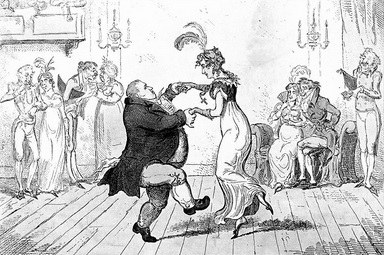
Figure 1. An 1813 couple dancing a Pousette like figure.
The word Pousette derives from the French pousser meaning to push . It typically involves a couple standing face-to-face and joining both hands; one person pushes the other backwards, they then reverse direction to return. The most common pousette variant involves two couples moving around each other, counter clockwise, in a whole strain of music. The word Pousette entered the lexicon of English Country Dancing from France somewhere around the year 1770, though as we'll see, the figure itself is somewhat older.
Figure 1 shows a couple dancing what could be a Pousette1. They have joined both hands as in a pousette (we can't see the direction of movement though). This scene is probably a caricature of the Waltz rather than a pousette, the couple depicted were influential in popularising that dance form in London in the 1810s. The Pousette figure is largely unrelated to the Waltz dance but the image might be helpful in visualising a delicate Pousette embrace. Imagine one partner pushing the other backwards for a few steps then changing direction to return.
The typical Pousette figure involves two couples and is depicted with stick-figures in Figure 2. It is a c.1817 illustration showing two couples moving around each other2. A further example pousette is suggested in Figure 9, this is a detail from a c.1795 caricature of a Country Dance by Rowlandson3, the couples may be depicted mid-pousette (though once again this may not in fact be a pousette figure). If they are intended to be dancing a Pousette then they've returned into a near perfect longways line; if a pousette is danced with elegance then the dancers should find themselves in a perfectly straight line half way through the figure, then again at the end of the figure. But more of that later.
The Pousette in Cotillion Dancing
The word Pousette entered England from France through the Cotillion or French Country Dances (that is, square formation dances) of the 1760s. The French writer De La Cuisse described two different Pousette figures for use in Cotillion dances in 1762. He wrote (I've translated using Google Translate) Pousettes are holding hands with a lady and pushing ahead, the lady in turn pushes the gentleman. Sometimes Pousettes are done by rotating around each other. 4. His first variant was a simple backwards and forwards movement by a single couple, the second involved two couples swapping places. He illustrated the second of these variants in Figure 35. This rotational pousette involves the couples moving around each other with each individual facing the same direction throughout the journey. The head man pulls his partner into the side couple's place, at the same time the side lady pulls her partner into the head couple's place; they then repeat the figure to return to their original positions.
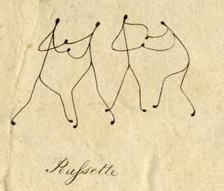
Figure 2. An 1817 Illustration of a Pousette.
The first collections of Cotillion dances to be published in England were issued in the late 1760s. These Cotillions occasionally feature the Pousette figure, several writers of the period described the figure for us. Giovanni Gallini writing of Cotillion dances c.1772 informs us that the Pousette is performed by holding the Lady's hands, and making her Retreat, then She does the same by Her Partner 6. His description matched the first of De La Cuisses's Pousette variants (that is, a simple backwards and forwards motion), Gallini's Pousette did not involve two couples moving around each other. Henry Bishop's 1790 Bruce Castle Cotillon contains an example of this simple figure7.
Another early commentator in London was Monsieur Gherardi. He described three Pousette variants in his 1768 A Second book of Cotillons or French Country Dances. I've not located an online copy of this document so I'll instead quote from Volume VI of Dr. John Gardiner-Garden's epic Historic Dance series8 (it's essential reading if you're interested in historic dance). Gherardi wrote of three Pousette variants, the first two match those of De La Cuisse, the third is a new figure:
- The Simple Pousette
is by taking the lady by both hands, & pushing her before you; she, in turn, does the same; & so you return to your place.
- The Rotational Pousette
is by two couples forming a kind of oval round each other: the lady of one couple pushing the gentleman before her, one half of the oval; & he her, the remainder; so that they return to their own places, standing in the same form as before they set out; the other couple perform the same figure, only the gentleman pushing the lady before him, the first half; and she him, the remainder. (see Figure 4 for Gherardi's illustration of this figure)
- The Chain Pousette
is performed by four couples; each gentleman taking his partner by the hands, & pushing her before him, & the four couples, moving together, form the figure of a chain.
Gherardi provided a diagram for his chain pousette that depicted a double progression longways dancing figure. I've not identified any dances that explicitly use this figure but it's interesting to note that it existed. Gherardi's rotational pousette (he named it Poussette en tournant but I'm using the word rotational to avoid confusion later on) can be both a longways country dancing figure or a Cotillion dancing figure. It's interesting that Gherardi described a kind of oval movement, if taken literally then this allows for greater sideways movement in a longways dance. Gherardi provided an illustration for this figure and, as with De La Cuisse, he depicted the individual dancers facing the same direction throughout the Pousette (see Figure 4). The couples rotate around each other then return to places.

Figure 3. The 1762 De La Cuisse Pousette.
The Pousette in English Country Dancing (ECD)
We've seen that Monsieur Gherardi depicted Pousette figures in what appear to be a longways formation back in 1768. It took a while for the word pousette to appear within published country dances however, the earliest example that I've found (within a published Country Dance) is the 1779 Ruffs and Rhees by Ignatius Sancho9. The Pousette would go on to become a ubiquitous country dancing figure in the 1780s and 1790s. Gherardi may have been ahead of his time in describing a longways Pousette back in 1768, I have a theory about this that we'll come back to.
Sancho's dance explains the Prussett as the first and second couple move intirely round each other till they arrive at proper places , see Figure 5. This is the same rotational Pousette that we've seen in De La Cuisse and Gherardi but this time it's explicitly used within an English Country Dance.
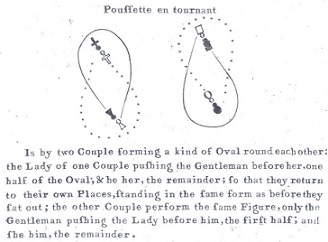
Figure 4. The 1768 Gherardi Pousette.
As an aside, Sancho is an incredibly interesting character. He was one of the first people to publish a collection of Cotillions in England, perhaps doing so as early as 1767; by 1779 he was the first country dance creator that I know of to use the term Pousette in an English Country Dance (and also amongst the first to use Promenade too); he's also responsible for creating several of my favourite dances. Oh yes, he was also born a slave, became an influential abolitionist and is believed to have been the first black man to vote in a British Election!10 I'm lucky enough to be a member of the Hampshire Regency Dancers, a group that regularly dance Sancho's dances.
The country dancing pousette of the later 18th century appears to have been a full two-couple rotation figure, similar to what we've seen in the cotillion dances. At some point over the following 30 or so years the terminology evolved. Thomas Wilson (a prolific author on all subjects pertaining to country dancing) writing in 1808 described a figure that he named the Pousse11 (he would go on to name it the pousette in later publications). Wilson's figure was similar to a that of a regular rotational pousette except that the couples rotate one-and-a-half times in order to change places. They were expected to do so in the same amount of music as would be expected of a regular rotational pousette, Wilson's figure was evidently danced a little faster. By 1820 Wilson would go further and describe two distinct figures, the Half Pousette or Draw12 and the Whole Pousette13. Wilson's Half Pousette is the figure that we've previously identified as the Rotational Pousette, his Whole Pousette is the new figure in which the couples rotate one and a half times (see Figure 6). Wilson's use of Half and Whole differs from the terminology that's usually employed in a modern ballroom, this can lead to confusion; anyone interpreting a Wilsonian dance should be aware of Wilson's use of this terminology. Wilson's Half Pousette was a short non-progressive figure danced to a half strain of music (typically 4 bars of music), his Whole Pousette used a whole strain of music (typically 8 bars) and caused the couples to exchange places14. Wilson depicted a counter-clockwise pousette in his diagrams.
Wilson's terminology wasn't universal during the Regency period. The anonymous American writer known as Saltator described the Poucette figure in 1807 as give both hands to partners, by couples and dance round each other .15. His description isn't clear, it appears once again to be the Rotational Pousette. Saltator doesn't hint at Half and Whole variations or that the pousette should rotate one-and-a-half times. That said, his description doesn't rule such ideas out either. Wilson's great rival G.M.S. Chivers published a collection of Country Dances c.1823, Chivers used pousette at top as an 8-bar non-progressive figure just like the earlier pousettes of Sancho and others. Care is needed when interpreting country dances of the early 19th century, the Pousette figure may be progressive or non-progressive depending on context.
Wilson didn't invent the progressive pousette of course, there were Country Dances published in the 1780s in which the pousette was clearly progressional. He did however popularise the progressive pousette. He used it consistently within his own dances, he was the single most prolific publisher of Country Dance collections during the entire Regency era.
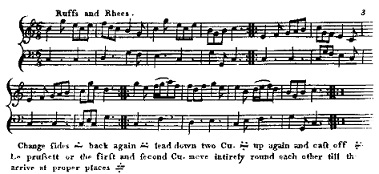
Figure 5. The Prussett in a 1779 English Country Dance.
Other Regency era writers to comment on the Pousette include John Cherry and G.M.S. Chivers. Cherry, in his c.1813 Treatise on the Art of Dancing wrote of both Whole Pousettes and Half Pousettes . He had the whole figure take 8 bars of music and the half figure take 4 bars, he suggested that neither was progressive (which is problematic). Chivers in his 1822 Modern Dancing Master wrote: Pousette - Two couple pass round each other to places . His description is not progressional either (though his choreographies did mix both progressional and non-progressional pousettes). The music publisher Martin Platts regularly featured a figure that he named the swing pousette in his dances of the early 19th Century, quite what he meant by the term isn't obvious.
The Waltz dance entered the English ballrooms from the start of the 19th Century, it triggered the invention of something named the Waltz Pousette. Thomas Wilson, for example, used this figure in his 1818 Le Sylphe16 dance collection. He employed such phrases as whole poussette with sauteuse step and waltz whole poussette . This appears to be a turning pousette, it could be the origin of the pousette figure used in RSCDS Scottish Country Dancing17. A further curiosity that links the waltz with the Pousette is an 1820 document named No 1 of Spanish Dances18, this document translates the Spanish term waltze as poussette in English.
The Pousette in Quadrille Dancing
The Quadrille was a new dance form that rose to popularity in Britain from around 1816; it was heavily influenced by the earlier Cotillion dance form (so much so that many early commentators struggled to discern a difference between the two formats). I'm not aware of many Quadrille dances that actually employed a Pousette figure, Thomas Wilson did however describe the Quadrille Pousette in his c.1818 Quadrille and Cotillion Panorama publication. Wilson used terminology that was consistent with that of his English Country Dances. He wrote of the Demie Poussette that: The Half Poussette in Quadrille Dancing is precisely the same as the Half Poussette in Country Dancing . He went on to add It nevertheless must be remembered, that the Couples must be brought into a suitable situation, by some previous movement, to perform this Figure, as the form of the Dance prevents them from performing it with propriety from their original situations in the Dance 19. Wilson included an example of this figure in the Finale to his c.1816 Quadrille Set.
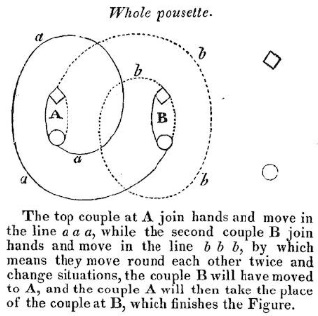
Figure 6. Wilson's c.1820 'Whole Pousette'.
This figure appears to be the same as the Rotational Pousette described by De La Cuisse and Gherardi, the illustration20 Wilson provided (see Figure 7) shows an important difference however. Wilson had the head couples in the Quadrille meeting in the middle, the pousette involves dancing with the vis-a-vis partners. In other words, you take hands with your opposite not with your partner . It's likely that this figure was also used in earlier Cotillion dances too, no writer that I'm aware of prior to Wilson described this variant of the figure but it may well have been danced.
The Pousette Mysteries
We've seen how the term Pousette entered the English ballrooms from the late 1760s, it then entered the lexicon of English Country Dancing in the late 1770s. The story is not that simple however. The pousette figure had already existed in English Country Dancing prior to this date, it simply did so under a different name! The anonymous A.D. author wrote in their 1764 publication of a Country Dancing movement named Drawing. A.D. described drawing as: Drawing is when two persons are face to face, and joining both hands, the one moving backwards and drawing the other forwards, in any figure directed 21 (See Figure 8). This is clearly the Simple Pousette figure, it's just described with a different name.
A.D. didn't indicate whether the Draw was to be performed with another couple or not, the implication is that it could be. You may have noticed that Thomas Wilson also described his c.1820 Half Pousette figure as a Draw . I have a suspicion that the English Draw figure could be the original source from which the French Pousette is derived - maybe the French dancing masters adopted the English Draw but replaced the name with the French word for Push . This is just a theory but it does seems to fit the evidence. I'm not aware of many country dances published in England that used the word draw within them but the term was evidently known. A.D. went on to describe a pair of figures that explicitly involved the Draw:
To Draw off round the second couple the first man and third woman must move backwards quite round the second couple, into their proper places. This is often done half round, and back again. This requires very short steps, eight is too few to get round with, and sixteen common steps bring you too soon to your places.
To Draw off behind the second man and third woman in this only one couple moves, the man drawing the woman; it may also be done the other way, by the woman drawing the man, or in any figure the composer of a dance may please to direct.
Colin Hume in his Pousette essay22 identifies a number of older English dances of the Playford era that feature Pousette like figures but don't use the word Pousette . Some of them do use the word Draw however. For example, he found the 1697 Mad Moll23 in which The 1. cu. take hands and draw into the 2. cu. place; the 2. cu. at the same time hands to the 1. cu. place . This appears to be half of a rotational pousette (not to be confused with Wilson's Half Pousette!).
Addenda: A reader (George Williams) has written in to share an example of a Pousette like figure that appeared in a c.1726 Irish dance collection by John & William Neal. His A Choice Collection of Country Dances included a dance named A Young Virgin of 15 Years that includes the instruction 1st & 2d men take both hands wth their partner's and back to back till in their own places . This seems to have been an attempt to explain the movement involved in a Draw figure without using that word. Whereas I've encountered the word Draw used in place of Pousette in a collection of Cotillion dances published in London in 1773 by V. Southern of Hull; this is a relatively late use of the term Draw and most unusual in Cotillion dancing.
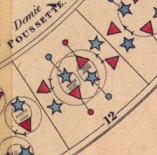
Figure 7. Wilson's c.1818 'Demie Poussette'.
Colin Hume's essay goes on to question whether the figure known in modern dance halls as the Draw Pousette has a historical basis. Modern Callers use this term to describe a figure in which the couples wheel around while pousetting such that they reach their progressed position improper (the man on the ladies side). I've not found any significant evidence for the existence of this figure in the late 18th and early 19th centuries. In the 18th century the terms Draw and Pousette appear to have been synonyms. Thomas Wilson did refer to a Draw Poussette in his c.1818 description of the Tiroir Quadrille figure24, he also featured the term in some of his later Country Dances such as the 1819 Elfrida, unfortunately Wilson didn't explain what he meant by the phrase. A modern draw pousette would be useful when dancing a Spanish Country Dance or Ecossoise ; these dance forms were variants of English Country Dancing that arose in the 1810s in which the first couple begins the dance improper, they often involved figures that would cause the dancers to swap sides.
A related anomaly can be found with a figure used within the c.1793 manuscript of an American musician named Asa Wilcox. Asa notated a version of the Colledge Hornpipe and instructed first & third Couple Draw 25 (this is before the first couple progress). The instruction seems to imply a pousette around the middle couple as in A.D.'s Draw off round the second couple . I've animated it using the modern draw pousette as that involves less travelling and is easier to dance in the time available. I've also animated a draw pousette in Gallini's c.1772 L'impromptu Cotillion26;
this dance calls for a Poussette and change places figure, a draw pousette at the side fits this quite well.
Other semi-mythical pousette figures that appear in modern dance halls are the Half Pousette and the Split Pousette. The half pousette in this context is the same figure we saw from Mad Moll; it clearly did exist but I've not found evidence of its use in any Regency era dances (other than as Wilson's Half Pousette , but that's a regular Pousette in double time to everyone else!). Wilson also hinted at a half-strain progressive Pousette existing with a full one-and-a-half rotations: Poussé is sometimes danced in half a Strain, to bring in the Dance to some particular tunes, but this is sure to destroy the effect of the figure, and cause confusion, as it must be danced so very quick 27. A modern Half Pousette looks much better than a double speed Wilsonian Whole Pousette. The closest I've found in a Regency era source is a c.1809 dance named Scrub's Delight by Mrs Elliston, she provided the instruction pousette down one Couple which could imply a modern half pousette in a half strain of music.
The split pousette is often used by modern Callers as a way to convert a triple minor dance into a three couple set. In this variant the top two couples dance half of a pousette, then the bottom two dance the other half, resulting in a double progression.

Figure 8. The 'Drawing' motion described by A.D., in 1764.
There's another mystery in Mr. Gray's 1803 Edinburgh Races dance. He introduced the following figure: chain pousette with the top and bottom couple 28. This figure begins with the first couple progressed. It can't be a split pousette as that would return the first couple to the top of the set; it can't be Gherardi's Chain Pousette as that needs four couples; it could be two of Wilson's half pousettes, I've animated it as the the top and bottom couples pousette around the middle couple. A similar term can be found in Pousette 3 Couple as seen in the c.1808 The Prime of Life (from Wheatstone & Voigt's 3rd Book) and the 1811 The Burdett (printed in Glasgow by Penson Robertson & Co.). There's clearly scope for other pousette variants having existed in the past, writers such as Thomas Wilson attempted to record everything there was to know about country dancing but they inevitably missed things.
Our Policy for Pousette Figures
Here at RegencyDances.org we generally use the modern Pousette terminology. We use Half Pousette for a progressive figure in a half strain; Pousette or Full Pousette for two half pousettes in a full strain of music (the dancers return to where they started); and One and a Half Pousette for a progressive pousette in a full strain of music.
You may have noticed that there are many different spellings for Pousette . It's also known as Poussette (or Poußette), Pousse, Poussett, Poucette, Perssette, Prussett, Poussée, Pousset, Pausette, Pussett, Posette, Pousét and probably other variations I've missed. We usually use Pousette , though you may find other variations around the site.
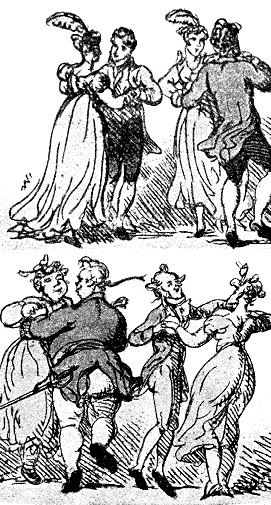
Figure 9. Details from a c.1795 caricature of a Country Dance.
We do occasionally animate questionable Pousette variations, several of which have been mentioned in this article. Feel free to substitute our suggestions with something else, if you want to dance a variation.
Finally, if
you're reading this and know about some clues that we've missed,
please do get in touch. We'd love for further evidence to be found!
References
1. Cruikshank, 1813, Longitude and Latitude of St Petersburgh
2. Anonymous, c.1817, Asking to Dance
3. Rowlandson, c.1795, Caricature of a longways country dance
4. De La Cuisse, 1762, Le
répertoire des bals
5. De La Cuisse, 1762, Le
répertoire des bals
6. Gallini, c.1772, A
New Collection of 44 Cotillons
7. Bishop, 1790, Bruce Castle Cotillon
8. Gardiner-Garden, 2013, Historic Dance, Volume VI
9. Sancho, 1779, Ruffs and Rhees
10. Wikipedia, Ignatius Sancho
11. Wilson, 1808, An Anlysis of Country Dancing
12. Wilson, c.1820, The Complete System of English Country Dancing, Half Pousette
13. Wilson, c.1820, The Complete System of English Country Dancing, Whole Pousette
14. Wilson, c.1820, The Complete System of English Country Dancing
15. Saltator, 1807, quoted by Ralph Page in The History of Square Dancing
16. Wilson, 1818, Le Sylphe
17. Scottish Country Dancing Dictionary, Poussette
18. Wheatstone, 1820, No 1 of Spanish Dances
19. Wilson, c.1818, The Quadrille and Cotillion Panorama
20. Wilson, c.1818, The Quadrille and Cotillion Panorama
21. A.D., 1764, Country-Dancing made Plain and Easy
22. Colin Hume, Poussette Essay
23. Playford, 1697, Mad Moll
24. Wilson, c.1818, The Quadrille and Cotillion Panorama
25. Wilcox, 1793, Book of Figures
26. Gallini, c.1772, L'Impromptu Cotillion
27. Wilson, 1808, An Anlysis of Country Dancing
28. Gray, 1803, Edinburgh Races
| 

 Figure 4. The 1768 Gherardi Pousette.
Figure 4. The 1768 Gherardi Pousette.